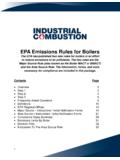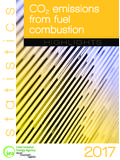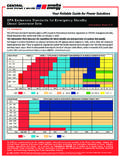Transcription of Non-exhaust PM emissions from electric vehicles
1 Review articleNon- exhaust PM emissions from electric vehiclesVictor Timmersa,*, Peter AchtenbaUniversity of Edinburgh, Edinburgh EH8 9YL, UKbINNAS BV, 15 Nikkelstraat, 4823 AE Breda, Netherlandshighlights A positive relationship exists between vehicle weight and Non-exhaust emissions . electric vehicles are 24% heavier than their conventional counterparts. electric vehicle PM emissions are comparable to those of conventional vehicles . Non-exhaust sources account for 90% of PM10and 85% of traffic. Future policy should focus on reducing vehicle infoArticle history:Received 5 October 2015 Received in revised form4 March 2016 Accepted 7 March 2016 Available online 11 March 2016 Keywords: electric vehicleParticulate matterNon-exhaustPM10abstractParticulate matter (PM) exposure has been linked to adverse health effects by numerous , governments have been heavily incentivising the market to switch to electric passenger carsin order to reduce air pollution.
2 However, this literature review suggests that electric vehicles may notreduce levels of PM as much as expected, because of their relatively high weight. By analysing theexisting literature on Non-exhaust emissions of different vehicle categories, this review found that thereis a positive relationship between weight and Non-exhaust PM emission factors. In addition, electricvehicles (EVs) were found to be 24% heavier than equivalent internal combustion engine vehicles (ICEVs).As a result, total PM10emissions from EVs were found to be equal to those of modern ICEVs. were only 1e3% lower for EVs compared to modern ICEVs. Therefore, it could be concludedthat the increased popularity of electric vehicles will likely not have a great effect on PM levels.
3 Non-exhaust emissions already account for over 90% of PM10and 85% of from proportions will continue to increase as exhaust standards improve and average vehicle weightincreases. Future policy should consequently focus on setting standards for Non-exhaust emissions andencouraging weight reduction of all vehicles to significantly reduce PM emissions from traffic. 2016 Elsevier Ltd. All rights IntroductionAir quality is a large concern in Europe. According to the Euro-pean Environmental Agency (EEA), PM is one of Europe's mostproblematic pollutants in terms of harm to human health, beingresponsible for several hundreds of thousands of premature deathsin the European Region every year (European EnvironmentalAgency, 2014).Traffic is one of the main reasons why PM levels are too high,and is the primary source of PM in urban areas (Charron et al.)
4 ,2007; Kousoulidou et al., 2008; Pant and Harrison, 2013). vehicles emit PM through their exhaust and through non-exhaustsources, such as tyre wear, brake wear, road surface wear andresuspension of road dust (Thorpe and Harrison, 2008).PM is often divided into PM10and , which represent par-ticles with a diameter of less than 10mm and , link between exposure to PM and adverse health effects hasbeen well documented (European Environmental Agency, 2014;Valavanidis et al., 2008; Li et al., 2003; Gehring et al., 2015;World Health Organisation, 2014; Sacks et al., 2010). However,the precise effects on health due to exhaust and non-exhaustemissions are less well PM emissions are mainly made up of containa variety of hydrocarbons, which can contribute to respiratorydisease or lead to increased incidence of cancer (Kagawa, 2002).
5 *Corresponding Timmers).Contents lists available atScienceDirectAtmospheric Environmentjournal 2016 Elsevier Ltd. All rights Environment 134 (2016) 10e17 Non-exhaust emissions tend to contain mostly PM10, but a signifi-cant proportion of the emissions containsfine well. Thechemical characteristics of Non-exhaust PM emissions vary persource, but are mainly made up of heavy metals such as zinc (Zn),copper (Cu), iron (Fe) and lead (Pb), among others (Thorpe andHarrison, 2008). There are several toxicological studies that havefound links between Non-exhaust emissions and adverse healtheffects, such as lung-inflammation and DNA damage (Cassee et al.,2013; Gasser et al., 2009; Gualtieri et al., 2005; Mantecca et al.,2009; Karlsson et al., 2006), and a review of epidemiologicalstudies concluded that PM10indeed has an effect on mortality(Brunekreef, 2005).
6 Because of the chemical differences between Non-exhaust andexhaust emissions , they result in different secondary PM. Second-ary PM is formed in the atmosphere through chemical reactions,rather than being directly emitted by a source. The volatile organiccompounds in exhaust gases react with sunlight in the atmosphereto form secondary organic aerosols (SOAs) whereas non-exhaustemissions are mainly inorganic and therefore form secondaryinorganic aerosols (SIAs). However, it is exceedingly difficult tomodel SOAs and SIAs emissions (Hoogerbrugge et al., 2015; AirQuality Expert Group, 2012). Not only do many studies have diffi-culty determining the fractional contribution vehicles make toSOAs, but it is also problematic to differentiate between primaryand secondary PM (Amato et al.)
7 , 2013; Viana, 2011; Bahreini et al.,2012). Therefore, there is always the risk of double-counting PM(Humbert et al., 2015). SOAs may have a significant influence on PMlevels. However, more research is needed to determine their rela-tive importance. The largest part of the Non-exhaust emissions isresuspended PM, possibly including secondary PM emissions . Forthat reason we have not differentiated between primary and sec-ondary PM of the strategies being adopted in many European countriesto improve air quality is incentivising the electrification of pas-senger cars (EAMA, 2015; Mock and Yang, 2014). The switch to EVshas been proposed as a solution to air pollution, offering zeroemissions and promising cleaner air for everyone (DutchGovernment, 2011; EU, 2005; Murrells and Pang, 2013).
8 However,when modelling the impact of EVs on air quality,Soret et al. (2014)found thatfleet electrification would not significantly reduce PMemissions due to the importance of Non-exhaust literature review attempts to investigate this further bydetermining the weight difference between EVs and ICEVs, quan-tifying the impact this has on Non-exhaust emissions andfinallycomparing the total PM emissions from EVs and ICEVs. It isimportant to note that this literature review is only concerned withthe PM emissions from EVs and ICEVs. A complete understanding ofthe value of EVs versus ICEVs is beyond the scope of this Weight and Hypothesised influence of weightIt can be hypothesised that each of the sources of non-exhaustPM emissions should be influenced by vehicle know that road abrasion and tyre wear are caused by thefriction between the tyre thread and road surface.
9 Friction is afunction of the friction coefficient between the tyres and the road,as well as a function of the normal force of the road. This force isdirectly proportional to the weight of the car. This means thatincreasing vehicle weight would increase the frictional force andtherefore the rate of wear on both the tyre and road wear is caused by the friction between the brake pads andthe wheels. The energy needed to reduce the momentum of avehicle is proportional to the vehicle 's speed and mass. Therefore,as the mass of the vehicle increases, more frictional energy isneeded to slow it down, leading to greater brake is caused by the wake of a vehicle , which in turn isdetermined by the size, weight and aerodynamics of the , heavier vehicles are able to grind down larger parti-cles into smaller, more easily suspended PM.
10 In addition, manyheavier vehicles will also be larger, resulting in a larger wake. Thesefactors together should cause increased Evidence for influence of weightIn his paper,Simons (2013)presented new and updated datasetsfor emissions of passenger cars. He distinguishes between vehicleexhaust and Non-exhaust emissions and is one of thefirst to definenon- exhaust emissions as a factor of vehicle weight, with theintention of being applied to studies on hybrid and electric suggests that PM10emission factors could be scaled directlyto vehicle weight and provides emission factors for tyre, brake androad wear per kg of vehicle weight. For example, tyre, brake androad wear increase by around 50% when comparing a medium(1600 kg) and small (1200 kg) car.








